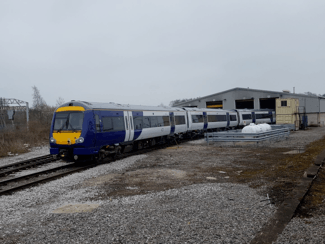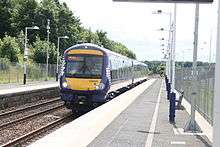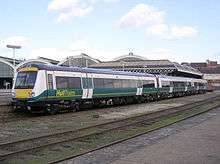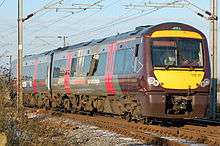British Rail Class 170
| British Rail Class 170 Turbostar | |
|---|---|
 A Northern Class 170/4 at The Arriva Traincare depot. | |
| In service | 1998–present |
| Manufacturer | Adtranz/Bombardier Transportation |
| Family name | Turbostar |
| Replaced | |
| Constructed | 1998–2005 |
| Number built | 122 trainsets |
| Formation | 2 or 3 cars per trainset |
| Operator(s) | |
| Specifications | |
| Car body construction | Welded aluminium. Steel ends. |
| Train length | 2 car: 47.22 m (154 ft 11 in) |
| Car length | 23.62 m (77 ft 6 in) |
| Width | 2.69 m (8 ft 10 in) |
| Height | 3.77 m (12 ft 4 in) |
| Maximum speed | 100 mph (160 km/h) |
| Weight | Varies between 90.41 t (88.98 long tons; 99.66 short tons) (170/1 2 car) to 135.31 t (133.17 long tons; 149.15 short tons) (170/1 3 car) |
| Prime mover(s) | One MTU 6R 183TD13H diesel per car |
| Power output | 315 kilowatts (422 hp) at 1,900 rpm |
| Transmission |
Voith Hydraulic T211rzze to ZF final drive 2 axles driven per car |
| Bogies | Powered: BREL P3-23 Unpowered: BREL T3-23 |
| Braking system(s) | Disc brakes |
| Safety system(s) | AWS, TPWS |
| Coupling system | BSI[1] |
| Track gauge | 1,435 mm (4 ft 8 1⁄2 in) standard gauge |
The Class 170 Turbostar is a British diesel multiple-unit (DMU) train built by Bombardier Transportation (and previously Adtranz) at its Derby Litchurch Lane Works. Introduced after privatisation, these trains have operated regional as well as long-distance services, and to a lesser extent suburban services. 122 units have been built.
Design
The class is a development of the design used in the British Rail Class 165 and 166 DMUs known as the Networker Turbos which were built by British Rail Engineering Limited and later ABB Transportation Ltd before that company became part of Bombardier.
Notable features shared are the aluminium alloy frame and Voith transmission as well as the general body shape (the cab ends are similar to those of the Class 168, but not Class 165/166), interior design and door fittings. The final drive is sourced from ZF instead of Gmeinder and the diesel-engine supplier is MTU.[2]
The engine and transmission are located under the body. One bogie per coach is powered. All coaches in the set are powered when in use (there are no unpowered trailers). The units can work in multiple with trains in the 15X series, i.e. Sprinters and Pacers, and with other units of the same class. They are unable to operate in multiple with units in the 16X series due to different wiring arrangements.[3]
Seating arrangements are of both 2+1 (first class) and 2+2 (standard class) formation, and give a seated passenger capacity of between ~100 and ~200 per three-car set (depending on the specifications of the operator).[4] 2-car sets are also operated.
Subclasses
Class 170 units have been categorised into six sub-classes; the basic specifications remain the same (engine, length, transmission, etc.), the differences being the seating arrangements specified by the different operators. Because of the different interior fittings the sub-classes differ in weight from one another by a small amount, up to ~2 tonnes.[3]
All the subclasses were built at Derby works either under Adtranz or Bombardier Transportation ownership.[3]
Operations
Most units are owned by Porterbrook, although units 170416–424 are owned by Eversholt Rail Group.[5] They are leased to the train operating companies.
Scotland

Abellio ScotRail is the largest operator of the Class 170, with a fleet comprising 55 3-car sets. Originally, 34 of these had first-class accommodation. They are mainly used on Edinburgh–Glasgow (Queen Street), Inverness–Glasgow/Edinburgh and Aberdeen–Glasgow/Edinburgh services. An additional nine units were ordered and operated by Strathclyde Partnership for Transport (SPT), these now operate under the direction of Transport Scotland, which has authority over the entire ScotRail area. A further four 3-car sets (170393-396), fitted with 'mini-buffets', were obtained from Hull Trains, but the buffets are out of use and all four units were converted to standard class only in 2012.[6]
All units are allocated to Edinburgh Haymarket depot. In September 2008 the Scottish Government's agency Transport Scotland announced that all ScotRail trains (including from the Strathclyde Partnership for Transport) would eventually be repainted in a new blue livery with white Saltire markings on the carriage ends.[7]
In December 2008, half the standard-class-only units, 170450–5, were fitted with first-class sections. 170456 and 170457 were fitted with first class in December 2011. In April 2015, 170421-424 left ScotRail to go to Southern and be modified to become Class 171s.[8] In March 2018, the first four of sixteen units destined for further use with Northern left the fleet, with a further four departing in August 2018.[9]
Northern England
First TransPennine Express

First TransPennine Express operated nine Class 170s, used on the Manchester Piccadilly to Hull route. Originally Class 185s were set to operate the route but a combination of weight-restriction problems on the Selby to Hull Line, chronic overcrowding on several of the company's services and the government reducing the amount of money available to First TransPennine Express for new trains resulted in Class 170s coming into service.
From September 2009, two Class 170s were used Sundays to Thursdays on the Cleethorpes–Manchester Airport service.
First TransPennine Express received eight Turbostars from South West Trains, 170301–308 at the end of 2006 and the start of 2007, as well as 170399 from Central Trains in November 2007, which was renumbered 170309.
The units were maintained by Bombardier Crofton. The 170s have since been fully refurbished to include CCTV, power sockets throughout, replacement carpets and seat covers and the removal / declassification of one of the two first-class sections, providing more seats. The work was carried out by Transys at Clacton-on-Sea.
However, in March 2014 it was revealed that the nine Turbostars would move to Chiltern Railways.[10] MP Stephen Hammond revealed on 12 March 2014 that all the class 170/3s would remain with First TransPennine Express until the May 2015 timetable change, when Chiltern would take five of the 170s with the remaining four remaining with First TransPennine Express until the end of the franchise in March 2016 later changed to 8 July 2016. Upon delivery, the Class 170s were modified to allow them to be used with Chiltern's existing Class 168 units, and were subsequently reclassified as Class 168/3s.[11] Today, the unit numbers are 168321-168329.
Hull Trains
Hull Trains began its London King's Cross to Hull services using Turbostars, initially with four sets on short-term lease from Anglia Railways. In 2004, it received four of its own 3-car Class 170/3 units, and returned the original units to Anglia.
In 2005, following its acquisition by FirstGroup, Hull Trains received four new Class 222/1 Pioneer units and transferred the Turbostars to its sister company First ScotRail.
Northern
Northern began operating the Class 170 in 2018, with a total of sixteen units due from Abellio ScotRail by the end of the year. As of August 2018, Northern has ten units.
The Midlands

Midland Mainline (MML) was the first operator to order Turbostars, the first being introduced in 1998. The Class 170/1 were built immediately after the Class 168/0 were built for Chiltern Railways. MML ordered a fleet of seventeen 2-car Class 170 units, although the first ten were subsequently made up of three cars each instead. These were numbered 170101–117. The units were introduced on stopping services from London St. Pancras to Leicester, Derby and Nottingham. Some were also used on summer Saturday-only services from London to York, which later became a year-round service with summer extension to Scarborough.
In 2004, Midland Mainline introduced new Class 222 Meridian units, which started to replace the Turbostars. As a result, the fleet was transferred to sister company Central Trains. Ten units (170101-110) are 3-car units, and the remaining seven units (170111-117) are 2-car units. As with the three spot-hire units from Porterbrook, these seventeen units had first-class accommodation, which was declassified.
Central Trains had a fleet of 53 Class 170 units from various subclasses.
In 1999, Central received its first batch of twenty-three 2-car Class 170/5 and ten 3-car Class 170/6 units. These were used to replace Class 156 units on various longer-distance services.
From late 2004, Central also took three Class 170/3 on lease from Porterbrook. Units 170397–8 are 3-car units and 170399 is a 2-car unit. All three of these units contained first-class accommodation, which was declassified (allowing standard-class use throughout the train), as first class travel was not provided on Central Trains services. The two 3-car units' interiors were of Central Trains style, except the MML-style first class, and the 2-car unit had a South West Trains interior. After the Central Trains franchise ended, the two 3-car units (170397 and 170398) remained with the new operator, CrossCountry. The one 2-car unit was returned to Porterbrook, which then leased it to First TransPennine Express who renumbered the unit to 170309.
All Class 170 units in service with Central were used on a variety of services (mostly long-distance) including Birmingham–Stansted Airport, Nottingham–Cardiff and Birmingham –Leicester.
Class 170 units have been replaced by Class 350 Desiro units on Birmingham New Street to Liverpool Lime Street services.
When Central Trains lost its franchise in 2007, 23 of Central Trains' units (17 x 2-coach & 6 x 3-coach) were transferred to London Midland, which took over the West Midlands franchise and continues to use Class 170s for services on the Chase Line, Birmingham to Hereford via Bromsgrove Line and Shrewsbury services. 29 out of the other 30 (including all the ex-Midland-Mainline units, and two of the three spot-hire units) were transferred to CrossCountry and are used on the Cardiff–Birmingham–Nottingham and Birmingham–Leicester–Stansted Airport services. These Class 170 were refurbished in 2008 with the 3-car units repainted at Marcroft Engineering, Stoke on Trent, the 2-car units at EWS' Toton depot and the interiors done by Transys Projects, Clacton-on-Sea including the fitting of first class seating to the Class 170/5s and 170/6s.[12][13]
One of Central Trains' 170s (170399) went to First TransPennine Express and was subsequently renumbered 170309; East Midlands Trains did not receive any, despite taking over the previously Class-170-operated Liverpool-to-Norwich route. This route is now operated by refurbished Class 158 units.
Eastern England
Anglia Railways ordered two batches of Turbostars. The first batch of eight 3-car Class 170/2 units were built for London Liverpool Street to Ipswich, Norwich, Lowestoft and Bury St. Edmunds services. These supplemented the existing Class 86 locomotive-hauled trains from London to Norwich. Four of these units were later hired to Hull Trains from 2002–2004, before that company acquired its own Turbostars.
Other units, including the spot-hire set 170399, were used on Anglia's short-lived Norwich to Basingstoke 'London Crosslink' service. In 2002, Anglia introduced a new Cambridge to Norwich direct service, and acquired four 2-car units dedicated to working these services.
In 2004 the Greater Anglia franchise was won by National Express subsidiary One, rebranded as National Express East Anglia in 2008, and passed onto Abellio Greater Anglia in 2012. Since then, 2-car Turbostars have been used for the Cambridge to Norwich route, and also on new through services including Cambridge (via Ipswich), Bury St Edmunds (via Ipswich), Peterborough (via Ipswich) and Lowestoft (via Ipswich and East Suffolk Line or Ipswich and Norwich) - London Liverpool Street via Ipswich, although with a new timetable all Class 170 London services ended in December 2010, in favour of connecting branch line trains with GEML expresses.
The 3-car trains used to include a buffet and larger first-class area, but because more seating was needed, the buffet area has been removed and the number of first-class seats reduced.
South-West England
South West Trains (SWT) acquired a fleet of eight 2-car Class 170/3 units in 2000 (later to nine units supplemented by ex-Southern 170392), to supplement its existing Class 159 fleet. Units operated on London Waterloo to Salisbury, Reading to Brighton, Southampton local services, and occasionally on services to Exeter St Davids, though this was not a regular route for these units, as they do not feature end gangways, making it difficult to provide trolley services, and they lacked selective door opening for the short platforms at stations on the route west of Salisbury. All but one of these units were transferred to First TransPennine Express at the end of 2006, in exchange for some Class 158 Express Sprinters. Unit 170392 was transferred back to its original intended operator Southern and has since been reclassified and renumbered from 170392 to 171730.
Southern England
Southern obtained six 2-car Class 170/7 units, along with six 4-car Class 171/8 units, in 2003 to replace its ageing Class 205 and Class 207 units on services on the Marshlink Line and Oxted Line to Uckfield.
Southern later fitted these units with the Dellner type coupler used on its Class 171s, reclassifying its 2-car units as Class 171/7, replacing the standard BSI coupler fitted to Class 170s. This was done to allow them to couple to Class 377 EMUs in an emergency.
Southern later acquired 170392 from South West Trains, which became its 10th 2-car, 171730. This unit had already carried Southern livery, being ordered as an add-on to a Southern order to save costs, and was delivered accordingly in Southern livery as 170727. It was renumbered and reliveried at Ashford Chart Leacon Works before entering traffic.
At the end of the First ScotRail franchise in March 2015, 170416 to 170424 were returned to Eversholt Rail Group. The first five will remain in Scotland on sublease to Abellio ScotRail until March 2018, while 170421 to 170424 moved to Wolverton railway works in April 2015. They were overhauled and converted to Class 171s.[8][14] Two became two-car 171/2s and two four-car Class 171/4s.[15]
Future
In August 2016 Greater Anglia selected Class 755s bi-Mode units to replace all their diesel units including their 170s.[16][17]. The 12 Class 170s are scheduled to transfer to Transport for Wales in 2019.[18]
Sixteen Class 170 units will be cascaded to Northern from Abellio ScotRail in 2018.[19][20][21] The first four units transferred to Neville Hill TMD in May 2018, with one unit undergoing a full refurbishment prior to entering service.[22][23] As of August 2018, ten of the sixteen units have transferred to Northern.
The 23 West Midlands Railway 170s are due to go off lease/stored.
Current fleet details
| Class | Operator | Number | Built | Carriages | Unit nos. |
|---|---|---|---|---|---|
| 170/1 | CrossCountry | 17 | 1998–99 | 3 | 170101–110[24] |
| 2 | 170111–117[24] | ||||
| 170/2 | Greater Anglia | 8 | 1999 | 3 | 170201–208[24] |
| 4 | 2002 | 2 | 170270–273[24] | ||
| 170/3 | Abellio ScotRail | 4 | 2004 | 3 | 170393–396[24] |
| CrossCountry | 2 | 2002 | 170397–398[24] | ||
| 170/4 | Abellio ScotRail | 22 | 1999–01 | 3 | 170401–420, 170470–471[24] |
| 10 | 2003–04 | 170425–434 | |||
| 9 | 2004–05 | 170450–458[24] | |||
| Northern | 10 | 2004–05 | 170459–461, 170472–478[24] | ||
| 170/5 | West Midlands Trains | 17 | 1999–00 | 2 | 170501–517 |
| CrossCountry | 6 | 170518–523[24] | |||
| 170/6 | West Midlands Trains | 6 | 2000 | 3 | 170630–635[24] |
| CrossCountry | 4 | 170636–639[24] |
Named Units
Some units have names, these are as follows:[25]
- 170401: Sir Moir Lockhead OBE (Removed)
- 170405: Riverside Museum (Removed)
- 170432: Investor in People (Removed)
Accidents and incidents
- On 13 November 2005, 170207 collided with a car at a level crossing in Swainsthorpe, Norfolk, on the Great Eastern Main Line. The car driver was killed. The front of the train was damaged by the consequent fire from the wrecked car.[26]
- On 26 November 2005, 170431 hit a landslide near Moy on the Highland Line. The front of the train was derailed and damaged by the debris, the other 2 coaches remained railed.[27]
- On 12 September 2006, 170206 was derailed as it crossed the level crossing at Croxton, Norfolk, on the Breckland Line. A panel that formed part of the level crossing had become dislodged and fouled both railway and road.[28]
- On 27 July 2011, 170393 derailed after crossing over a set of faulty points at Princes Street Gardens on the approach to Edinburgh. The train was occupied only by 2 members of crew - neither of whom was injured.
- On 14 July 2013, 170272 collided with a car towing a trailer on a level crossing at Woodbridge, Suffolk, on the East Suffolk Line.[29]
- On 10 April 2016, 170204 collided with an agricultural tractor on a level crossing at Roudham, on the Breckland line. The tractor driver was seriously injured; the train driver and some passengers sustained minor injuries.[30][31] An investigation revealed that the tractor driver had obtained permission to cross the line.[32]
- On 15 October 2017, 170272 collided with a car on a level crossing at Melton, on the East Suffolk Line. The car driver was airlifted to hospital.[33]
- On 10 October 2018, 170402 derailed at Stonehaven, between Aberdeen and Dundee.[34]
Gallery
- Central Trains' 170518 at Peterborough
 Refurbished first class accommodation on board a Scotrail Class 170/4
Refurbished first class accommodation on board a Scotrail Class 170/4
References
- ↑ "Mechanical And Electrical Coupling Index". Rail Safety and Standards Board. Archived from the original on 21 December 2013. Retrieved 20 December 2010.
- ↑ TURBOSTAR – United Kingdom bombardier.com Archived 13 June 2011 at the Wayback Machine.
- 1 2 3 "therailwaycentre.com".
- ↑ TURBOSTAR – United Kingdom – technical data – bombardier.com Archived 13 June 2011 at the Wayback Machine.
- ↑ Pritchard, Robert; Hall, Peter (2013). British Railways Locomotives & Coaching Stock 2013. Sheffield: Platform 5 Publishing. pp. 234–8. ISBN 978-1-909431-02-7.
- ↑ "Class 170 Formations". scot-rail.co.uk. Retrieved 17 October 2017.
- ↑ transportscotland.com – New Scottish livery
- 1 2 "Scottish Class 170/4s move south after transfer to Southern" Rail Magazine issue 772 15 April 2015 page 12
- ↑ Northern takes delivery of two ScotRail Class 170s Rail Technology Magazine 12 March 2018
- ↑ "Campaigners' fury as nine TransPennine Express trains sent south in 'crazy and scandalous' move". Manchester Evening News. 3 March 2014. Archived from the original on 12 March 2014.
- ↑ Broadbent, Steve (4 March 2014). "Chiltern plots further expansion". Rail (769): 46–53.
- ↑ Refurbishment of Class 170 Turbostar trains begins CrossCountry Press Release 30 January 2008
- ↑ CrossCountry's first refurbished Turbostar enters service CrossCountry Press Release 19 May 2008
- ↑ "Extra Turbostars for Southern" Today's Railways issue 162 June 2015 page 63
- ↑ "Southern 171s" Rail Magazine issue 804 6 July 2016 page 30
- ↑ Newly refurbished Class 156 train re-enters service Abellio Greater Anglia 3 December 2012
- ↑ Stadler and Bombardier to supply trains for Abellio East Anglia franchise Railway Gazette International 10 August 2016
- ↑ "What this means for Mid and South West Wales". Transport for Wales. Transport for Wales. Retrieved 4 June 2018.
- ↑ "Scotrail franchise agreement" (PDF). Transport Scotland. Archived from the original (PDF) on 29 November 2015. Retrieved 26 March 2016.
- ↑ "Franchise Agreement - Great Western" (PDF). gov.uk. 22 March 2015. Retrieved 26 March 2016.
- ↑ https://www.pressreader.com/uk/rail-uk/20170816/282175061225230
- ↑ "A Class above - ScotRail 170 trains arrive at Northern". northern-newsroom.prgloo.com. Retrieved 14 March 2018.
- ↑ Beard, Alexander (21 May 2018). "New fleet of trains roll on to Harrogate line". The Yorkshire Post. Retrieved 21 May 2018.
- 1 2 3 4 5 6 7 8 9 10 11 12 Clinnick, Richard (2009). "Britain's future-facing fleets". Rail (634): 66–73.
- ↑ http://abrail.co.uk/dmuformations2017.htm
- ↑ "Passenger train collision with a road vehicle at Swainsthorpe level crossing, Norfolk 13 November 2005" (PDF). Rail Accidents Investigation Branch. March 2006. Retrieved 11 April 2016.
- ↑ "Derailment near Moy, Inverness-shire" (PDF). Rail Accidents Investigation Branch. November 2006. Retrieved 6 June 2018.
- ↑ "Derailment of a train at Croxton Level Crossing 12 September 2006" (PDF). Rail Accidents Investigation Board. May 2008. Retrieved 10 April 2016.
- ↑ "Collision between a train and a car at Jetty Avenue level crossing, Woodbridge, Suffolk 14 July 2013" (PDF). Rail Accidents Investigation Branch. December 2014. Retrieved 11 April 2016.
- ↑ Bishop, Donna-Louise (10 April 2016). "Tractor driver suffers serious injuries following collision between train and tractor at Roudham, near Thetford". Eastern Daily Press. Archant Media Ltd.
- ↑ "Train carrying 135 passengers crashes at level crossing". ITV News Anglia. Retrieved 10 April 2016.
- ↑ "Collision near Thetford". Rail Accidents Investigation Branch. Retrieved 22 April 2016.
- ↑ Steward, Michael. "Man airlifted to hospital after car struck by train at level crossing at Melton". East Anglian Daily Times. Archant Community Media Ltd. Retrieved 15 October 2017.
- ↑ "Derailment at Stonehaven". BBC News. Retrieved 12 October 2018.
Further reading
| Wikimedia Commons has media related to British Rail Class 170. |
- "Central spends £48m to order 50 more 'Turbostar' DMU cars". RAIL. No. 339. EMAP Apex Publications. 9–22 September 1998. p. 7. ISSN 0953-4563. OCLC 49953699.
- West, Lee (7–20 October 1998). "'Turbostar' is ready to roll!". RAIL. No. 341. EMAP Apex Publications. pp. 22–25. ISSN 0953-4563. OCLC 49953699.
- "Adtranz launches Turbostar for Midland Mainline". RAIL. No. 344. EMAP Apex Publications. 18 November – 1 December 1998. p. 16. ISSN 0953-4563. OCLC 49953699.
- "Sanding gear for '170s'". RAIL. No. 345. EMAP Apex Publications. 2–15 December 1998. p. 8. ISSN 0953-4563. OCLC 49953699.
- "New numbers for Turbostar and Electrostar fleets". RAIL. No. 345. EMAP Apex Publications. 2–15 December 1998. p. 9. ISSN 0953-4563. OCLC 49953699.